Bike Lane Backlash?
As bicycle advocates have been getting new lanes and other concessions in major cities across the country, a minor backlash has formed in reaction.
As bicycle advocates have been getting new lanes and other concessions in major cities across the country, a minor backlash has formed in reaction. Scott Goodman, reporting for the NYT:
Bowing to vocal opposition from drivers and elected officials, the city last week began removing a 2.35-mile painted bike lane along Father Capodanno Boulevard on Staten Island. In Manhattan, a community board held a special hearing this month for business owners to vent about problems posed by a new protected bicycle lane on Columbus Avenue — in particular, the removal of parking spaces and the difficulty of getting truck deliveries.
In Brooklyn, new bicycle lanes have led to unusual scenes of friction. Along Prospect Park West, opponents protested last month alongside supporters of the lanes. And last year, painted paths along Bedford and Kent Avenues in Williamsburg caused disagreement between cyclists and Hasidim. The lane on Bedford Avenue was later removed.
So far, the opposition to the city’s agenda on bicycles has far less organization and passion than the bicycling advocates, but it is gaining increased attention.
[…]
Surging bike ridership has created a simmering cultural conflict between competing notions of urban transportation. Many New Yorkers object to bicycle lanes as sudden, drastic changes to their coveted concrete front yards.
[…]
Outside the city, bikes have begun creeping into political battles this year. The Republican nominee for governor of Colorado, Dan Maes, wondered during the primary whether bicycles were part of a plot to ruin cities. Mayor Adrian M. Fenty, who lost his bid for re-election in Washington, found himself painted as out of touch with residents, in part because of his connection to new bike paths.
Now, my sense is that this “backlash” is commensurate the one we’re seeing over the new airport screening procedures, with growing expressions of outrage coinciding with polls showing overwhelming quiet support. Whether either will grow into something more remains to be seen.
Still, this is a natural and entirely predictable fight. Despite the “share the road” mantra, the fact of the matter is that cars and bicycles are diametrically opposed transportation cultures that have extreme difficulty co-existing in the same space — at least in areas with serious traffic. (Which is to say: a tiny number of cities across the country.) Cars are heavy and fast moving and a constant danger to bicycles, which in addition to being vulnerable are also more difficult to see. Bicycles are a nuisance, blocking a coveted traffic lane by moving much slower than the speed limit. Moreover, they operate under conflicting sets of rules. Motorists more or less obey road signs and traffic signals, while bicyclists view them as merely advisory.
Adding to the complication is the issue of pedestrian traffic which, again, is a serious issue in the handful of major cities where the car-bicycle conflict exists at any meaningful level. Pedestrians take their lives into their hands, fearful of being struck by impatient motorists or lawless bicyclists. (And then there are the pedestrians who dart out into traffic, oblivious to the rules.) Gaggles of pedestrians lollygagging across an intersection frustrate motorists trying to make turn while backing up traffic behind said motorists. Meanwhile, bicyclists create their own lanes — passing motorists anxious to gun it at the first sign of a break in the pedestrian action or decide to become fast-moving pedestrians and drive on the sidewalk. Neither of these are helpful.
The hope, as a related piece from WSJ‘s Tom Perrotta implies, is that people will adapt to the new ecosystem and adopt customs that will allow all to interact reasonably well. Some cities have undertaken campaigns to educate drivers and bikers on the rules. He quotes Manhattan Borough President Scott Stringer, who observes, “Paris does it, Copenhagen does it. There’s a way for all of us to get things right.”
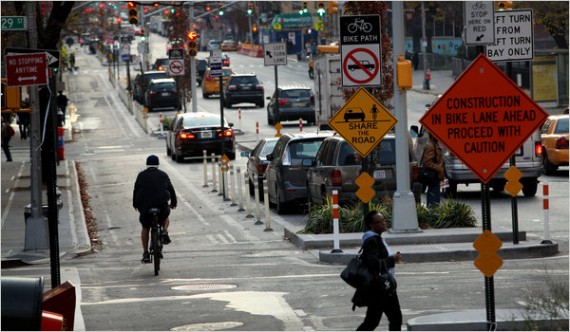

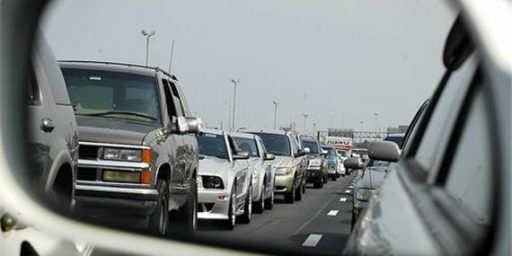
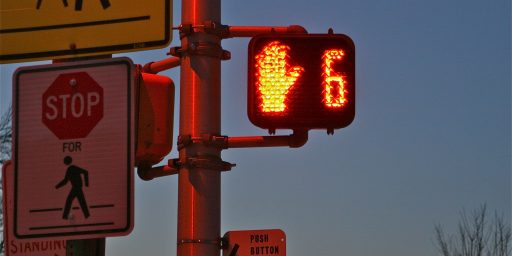
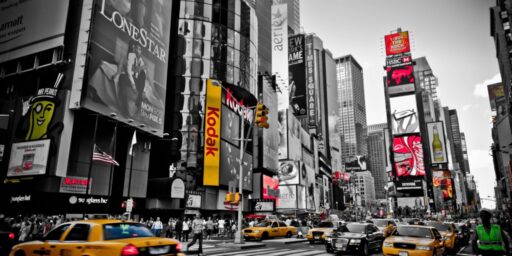
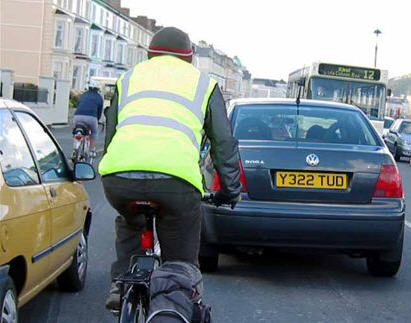
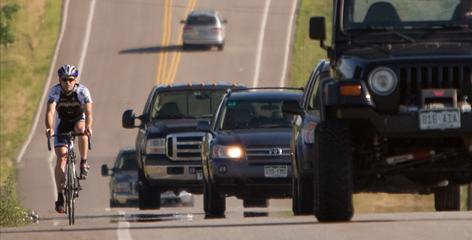
You sir, are a troll. 😉
“diametrically opposed transportation cultures”
“Bicycles are a nuisance”
Nothing here that requires serious response, but for anyone interested, I suggest as an antidote:
http://www.bikeleague.org/
(I also wish I’d saved the link to a recent story that 9 of 10 bike-car accidents in Australia were “car initiated.” I can be sympathetic, or empathetic, and guess that this is actually the source of driver fear. In a driver’s mind he does know what his 2500 pound car (if he’s made a reasonable choice) can do to a 150 pound rider, and so he fears the interaction. Bicycles are not a physical risk to the driver. They are a psychic risk, about what he might do, if he fails to spot one.
So, as much as I think car tribalism is bad, I can try to think that it comes from a good place, a desire to do no harm.
But obviously car tribalism, and bike hatred, are not really healthy responses.)
@John
They’re definitely very different cultures at the moment, making co-existence difficult. The differential speeds and vulnerability are problematic, but the different ways they drive is the key issue to be solved.
The roads are fundamentally for cars and the sidewalks for pedestrians. If bikes are going to go somewhere, it’ll have to be the former, I think, which means bicyclists will have to adapt to the rules of driving. Running red lights, passing in non-existent lanes, etc. will have to cease in high traffic areas.
I do like the idea of bike lanes and otherwise promoting getting around the city by bike. But we need to evolve to an Amsterdam-like culture for it to really work.
For decades I was a dedicated cyclist–I still have a Lemond and a Klein hanging in my garage. While I haven’t ridden since my knee replacement a few years ago, I still consider myself a cyclist and am very sensitive to them. But sometimes, they friggin annoy me by abusing their rights. I was on a climb in Skyline Drive in Virginia a couple of months ago and got behind a group riding four abreast across the lane. Suffice it to say that I’m skilled enough on manuevering the motorcycle that I was able to send a clear signal of my disapproval as I split between them.
Every time this comes up I say something that is conveniently ignored:
In America, adult bicyclists are also drivers.
What you are really looking at is pure-drivers with an attitude about bicyclist-drivers.
(Your second paragraph is historically false. Roads in America supported bicycles before they supported cars. Since then, we’ve made some freeways and turnpikes into cars-only domains, but this is (in American history) a recent innovation.)
(Maybe you should cautiously ride a few miles, and safely develop some situational awareness. That might make you competent to comment on bike-car interactions.)
Steve, I think the thing we can do, as cyclist-drivers, is identify jerks in each group, without a blind jump to tribalism. Some bicyclists are idiots, as are some drivers.
I doubt James classes himself with the street racer down the street, but he sees bicyclists all as the red-light runner.
Classic prejudice, tribalism, and close kin to racism really. Put on lycra, and you are the “other.”
My experience in this regard is almost entirely DC based, as bicyclists weren’t an issue in other places I lived. 99% of the bicyclists I encounter on DC roads flout the rules, either by running lights, passing cars in the rightmost lane on the right, or hopping onto the sidewalk. I don’t believe I’ve ever seen a bicyclist stop at a red light and wait for the green, save for the few times when there’s so much traffic coming from the perpendicular lane that they can’t get away with it.
So, if you pass a bicyclist in a straight stretch, riding at the side of the road, do you wait up at the next light every time to see what he does?
How else would you really know that 99% break traffic laws?
BTW, passing cars along the right is legal and indeed taught in schools as the safe procedure here in California.
I hope you aren’t faulting bikers for what is taught to students in your schools.
@john: When I’m riding, I usually “make” the right hand lane only to the extent that (a) people pass me while I’m on the road (thus putting me de facto in a separate lane already) and (b) other drivers aren’t already employing the right side of the road to make a right turn.
James’ assertion that “99% of cyclists” are breaking the law I’ll take as hyperbolic, though it’s funny that he should consider cyclists to be the lawbreakers (they run lights! they run stop signs!) while he probably speeds on a regular basis, makes lane changes without a turn signal, uses the left lane to perform operations other than passing, and/or fails to yield to oncoming traffic under certain circumstances. Breaking the law is a contextual term. Cyclists typically do it in different ways — and with much greater control, at lower speeds, and with much less danger to those around them — than drivers. Hell, just take a look at statistics on driver-pedestrian interactions and bicycle-pedestrian interactions in DC and tell me that drivers “deserve” the road more than bicycles.
I just thought of something. Here in California we have buttons we can push to make traffic sensitive signals flip for bicyclists. They are like cross-walk buttons, but positioned so that you can reach them from the street.
I wonder if you are highly conscious of some intersection(s) out there that are traffic driven, but can’t detect bikes and don’t have buttons. That’s the only situation where I could see 99% of riders going on red.
(If you mean all across DC, then I’d guess you just have a mental filter in place. You just don’t see the legal cyclists. On each jerk you say “ah, bicyclists!”)
I’d just like to say that it’s very refreshing to be ten or so comments into a thread like this on a right-leaning blog and nobody has trotted out the old canard about how bicyclists don’t pay for infrastructure. (only a tiny fraction of roadway spending, especially in cities, comes from gas taxes – the only variable cost drivers ever pay). Well done, y’all.
I have no gripe against cyclists as long as they obey traffic laws. The problem is that the number of cyclists who routinely ignore traffic laws is alarmingly high. That poses a danger both to themselves and to drivers. It’s a bit like that wisecrack about lawyers that 90% of lawyers give the others a bad name.
In fairness to cyclists motorists frequently don’t obey the law, either. So, for example, I’m convinced that most people don’t know what it means to bring their cars to a full stop at a stop sign or signal. To come to a full stop a car must have rocked back on its wheels. Otherwise you’re just gliding through.
If you are a driver-only, you might benefit from reading these “Safety Tips for Bicyclists and Motorists”
http://dmv.ca.gov/pubs/brochures/fast_facts/ffdl37.htm
I’d guess that at least some of the instructions given to bicyclists are things where you thought “they can’t do that!” The tips are very much written with what I call “situational awareness” in mind, as in the “ride to the right” section.
I’ve got a 4-way stop on the way out from my house, and people have been annoying me by blasting around in a moving right (from my right). The thing is, they do it in cars, and I drive a car, so I can’t just say “cars!” Right?
(I might say low-life from that apartment complex, if I feel inclined. It’s human.)
Two things on your study Dave. First, kids are worse with cars and bikes. Second, I’d really want to inspect that light. With a small sample (one uni?) it matters a lot the situational dynamics.
@john personna:
Uh, no. But I’m frequently stopped at red lights behind other cars. Bicyclists pass, either between car lanes or one the right, and then run the red light, treating it as a yield sign. Riding in the suburbs or otherwise uncongested traffic, that probably makes sense. It’s dangerous in DC rush hour traffic.
It’s highly problematic when cars are turning right from the right lane. We’re conditioned to look for pedestrians and other cars, not bicyclists passing from out of nowhere.
I find it impossible to believe that the normal bike procedure in dangerous rush hour traffic is to run reds. If it is, check the drinking water. Someone has made the local population suicidal.
@John Personna
I’ve written previously about the problems with DC car culture. I’m not by any means arguing that drivers, myself included, don’t sometimes make situations worse. My point here is that we’re in the early stages of mixing conflicting cultures. Drivers and bicyclists break different rules. But, if everyone’s exceeding the speed limit by 10mph, the culture adjusts. It’s the admixture of two sets of drivers using different patterns that’s the problem here.
Maybe you should get everyone to read “Safety Tips for Bicyclists and Motorists” (or the DC equivalent) and lead with that.
@John Personna
There are a myriad of implausible road-related behaviors that are so commonplace in DC as to be “normal.”
It does seem like the culture varies by city, or even within each city. I recently had the experience of moving from the north side of Chicago to the south side in a university area, and the different biking driving cultures were night and day. On the north side the bicyclists were very good about riding sensitive to the situation (not blasting through stop signs when there are cars/bicycles/pedestrians there, following the spirit of the traffic laws, going the correct way down one way streets, etc.), and the drivers were pretty respectful, but if there was a problem it was nearly always a car that caused it.
On the other side of town around the university campus bicyclists are a real danger to pedestrians and drivers, constantly flaunting traffic laws and rules left and right. Too many of the bicyclists are just not experienced urban riders, and it shows.
We definitely need a culture shift, with drivers learning to drive on the same roads as bicyclists, but James’ point remains that many bicyclists need to better follow traffic rules.
Good Lord, I go to the DC DDOT page, click “bicycling for kids” and it is a “page not found.”
(Ryon, James doesn’t know the traffic laws, but wants bicyclists to some of them)
(To explain my last criticism, it seems that at least part of James’ attitude is shaped by a mistaken understanding of riding on the right. He’s not alone. Many in California freak when bicyclists ‘take a lane”, but there are the DOT guidelines saying to do it sometimes.)
Welcome to Chicago.
I can tell you, living in a large city with lots of cyclists, though not one myself, that asshole drivers are a far, far, far greater problem and danger to everyone else on the road than cyclists ever will be. Exponentially so.
I’ve been a serious rider for more than 30 years. My business is trucking and I drive a car. I see all sides of the conflict and essentially belong to each tribe. Common sense is the solution because most situations are unique and government mandated rules are generally one size fits all. Of course we know that means they don’t fit at all.
A little respect both ways will act as a lubricant to the friction. Cyclists choosing routes that minimize conflict helps as well as motorists giving space to a cyclist when passing. There will always be jerks but none of us should use those examples to declare war on all cyclists or all motorists.
This is something that will work itself out over time as we adjust to the presence of more bikes. I just wish government would stay out of it as their solutions usually don’t help.
Speaking of the rotten government. They’ve closed the State Park after the rains. If they hadn’t, I’d be mountain biking right now, and leaving all of you alone. In the meantime, I found a few historical amusements:
(some formatting seems to be coming through with the copy/paste)
you also needed decent roads, and the bicycle boom provided these, as well as a sense of the market. The automobile probably could have been built 20 years earlier, but the interest was not there.
J. K. Starley introduced the safety bicycle in 1885. People had been satisfied with the railroad–only with the bicycle did they think of long-distance travel over ordinary roads.
the pneumatic tire was invented by John Dunlop in Ireland in 1888 specifically for use in bicycles
the automobile would not have been able to compete with the railroad in comfort and speed without the hard-surface road and the pneumatic tire
http://www.clemson.edu/caah/history/FacultyPages/PamMack/lec122/auto.htm